
Positano is a town and commune on the Amalfi Coast of Campania, Italy, mainly in an enclave in the hills that reach down to the coast.
Climate of the Positano Salerno
Positano has a very mild, Mediterranean climate. Winters are very warm, with minimum temperatures rarely dropping below 6°C. Summers, on the other hand, are long, warm, and sunny, often refreshing with sea breezes. due to its comfortable weather and stunning scenery, Positano has been a tourist destination since Roman times, as evidenced by the discovery of villas in the bay.
Typical are the many steps leading from the top of the village to the upper part of the village and the valley area. The main beaches are Spiaggia Grande, Fornillo, La Porta, Fiumicello, Arienzo, San Pietro, Laurito, and Renmese, some of which are accessible by sea.
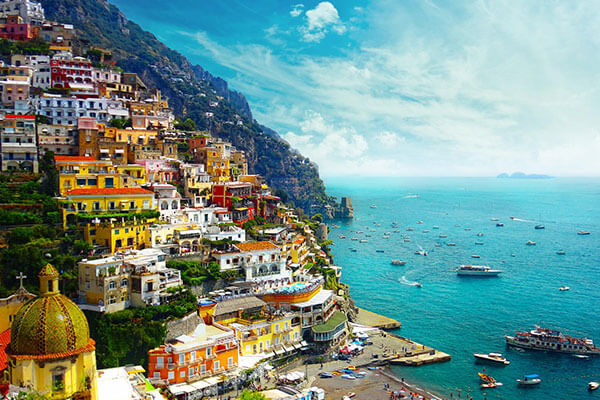
History of the Positano Salerno
The first evidence of Positano’s settlement dates back to the Upper Paleolithic when the “La Porta Grotto” was frequented by gatherers and hunters. This small cave is located at an altitude of 120 meters. It’s very wide on the highway and you can still distinguish between the edges and two gaps. In 1955, Antonio M. Radmilli organized several surveys to identify prehistoric visits both at the surface and in some caves.
Excavations have unearthed several fossils, including some that are soft stones and resemble seashells. Fish fossils are a prime example. The results suggest that the economy of cave dwellers was primarily based on collecting mollusks, with the hunting of birds and mammals of considerable importance.
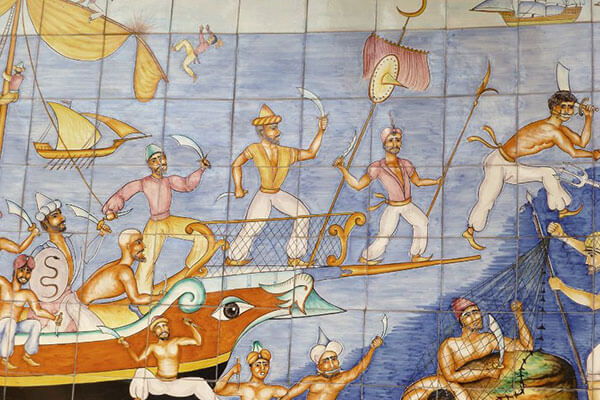
Roman era
The first archaeological evidence dates back to the 1st century BC. In BC, a luxurious Roman villa was built on the coast of the Sorrentine Peninsula. At Positano, one was in the bay, another his spread over Long Cock Island. This is an outstanding illustration of how the more remote regions of the wild coast were developed during the Cloudian era, without any respect for rocks or even rocks.
Later legends say that it was the home of the Sirens. These villas are ‘interspersed’. That is, it consists of various ungrouped structures separated by gardens. The owner’s name is not yet known, but it certainly has an elitist background. Villa di Positano was first described by Karl Weber in 1758. Weber was directing excavations at Herculaneum and Pompeii at the time.
In the early 20th century, Mingazzini and Pfister wrote several papers to better understand the structure of both Positano Gulf and Gallo Lungo. Maiuri describes several remains that can still be seen today as porticoes with stucco brick columns from the 1960s.
The complex has been the subject of his systematic excavations since 2003, covering the area under the Lesser Basilica of the Church of Santa Maria Assunta. The site was opened on July 18, 2018, under the name MAR Santa Maria Assunta Positano.

Modern era
Positano grew as a thriving market port between the 15th and 17th centuries, and its popularity continued to grow over time. At that time, they traded food such as fish and other resources.
Positano was the port of the Amalfi Republic after the sixteenth century, during the Middle Ages. he flourished in the 17th century. But in the mid-nineteenth century, the city faced difficult times. More than half of the population immigrated, most of them to the United States.
Positano was a relatively poor fishing village in the first half of the 20th century. In the 1950s, especially after John Steinbeck’s essay on Positano was published in Harper’s Bazaar in May 1953, it began to attract many tourists.
“Positano bit deep,” Steinbeck wrote. “It’s a dreamy place that’s utterly unreal when you’re there, but becomes charmingly real when you leave.”

Main sights of Positano Salerno
- The dome of the Santa Maria Assunta Church is tiled with majolica and a 13th-century Byzantine Black Madonna icon. Local lore holds that the icon was taken from Byzantium by pirates, who then transported it across the Mediterranean Sea. A storm was brewing in the waters opposite Positano, and the startled sailors heard shouts of “Posa, Posa!” The icon was unloaded and taken to a fishing village, and the storm died down.
- Located at the foot of the clifftop city of Positano, Marina Grande Beach is the town’s most famous beach. Other popular beaches include Fornillo Beach and Arienzo Beach.
- March Positano Santa Maria Assunta. This museum is a museum archaeological site that opened on July 18, 2018. The underground facility is divided into two cellars and a room in a Roman villa. The walls of the rooms with imperial frescoes are the only examples of wall paintings found in Roman villas on the Amalfi Coast. The site is characterized by particularly bright colors. Further archaeological investigations are planned for the recovery of other rooms in the complex.
Part of Positano for stay
Lower Positano
A must for night owls who like to wander around lively pubs and find fun things to do at night. Lower Positano is full of glowing bars with great views of the Amalfi Coast. Surrounded by Positano’s best attractions, it’s also the perfect place for first-time travelers to Italy. Also, those who like water sports and underwater excursions such as snorkeling and diving can make the most of their day trips from here.
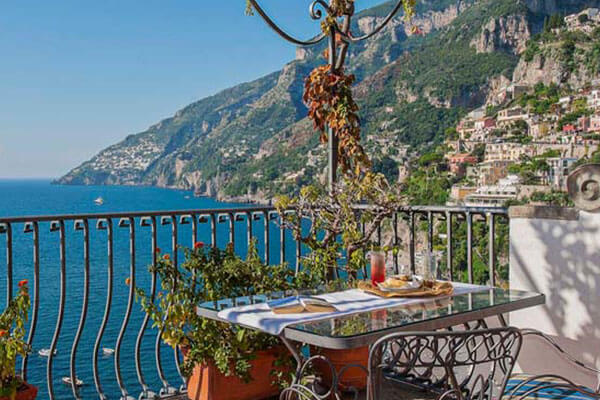
Montepertuso
A more secluded area, Montepertuso, a small village north of Positano, is a romantic place for families and couples. Adorned with lush emerald landscapes, waking up to breathtaking views of the Italian hills is the perfect way to start your vacation. Active travelers and adventure-seekers will find Montepertuso to be their mountaineering aid. To this village is a walk and he has to climb 1,500 steps.
Fornillo
Fornillo is the perfect area to base your visit in Positano. Here you’ll find the famous Fornillo Beach, west of Positano’s town center, and the Gulf of Salerno, where kayaking and water sports are popular. This charming area of Positano is a family-friendly area with easy access to all major facilities. In addition to Fornillo Beach, the area is also home to rustic wineries that serve famous shellfish and seafood.
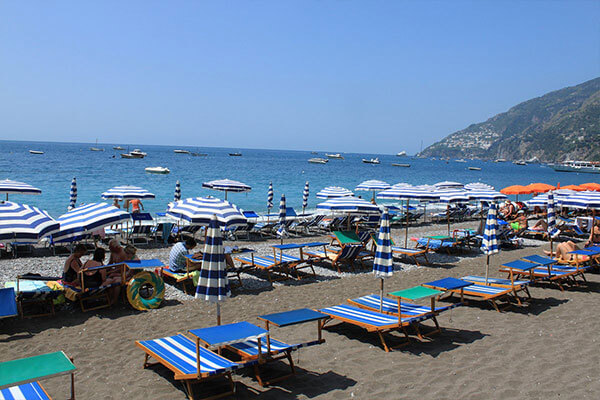
Culture of Positano Salerno
Positano has appeared in several films such as Only You, Under the Tuscan Sun, and most recently Cass and Cinderella, and has performed the song “Cinema Italian” which is also mentioned. It was also home to the annual Cartoons on the Bay festival, which awards the Pulcinella Award for outstanding animation.
From July 1967 through most of the 1970s, Positano was the home of singer his songwriter Sean Phillips, and most of his best-known works were written here. While on vacation, Mick Jagger and Keith Richards of The Rolling Stones wrote the song “Midnight Rambler” in a Positano cafe.
The famous film director and producer Franco Zeffirelli owned Villa Treville in Positano and lived there for 35 years, hosting many literary, stage, and film stars. He commissioned his friend Renzo Mongiardino, who has worked on several theatrical and opera projects, to design exquisite interiors that reflect the local design sensibility and craftsmanship. Later, Villa His Treville was converted into his 5-star boutique hotel.
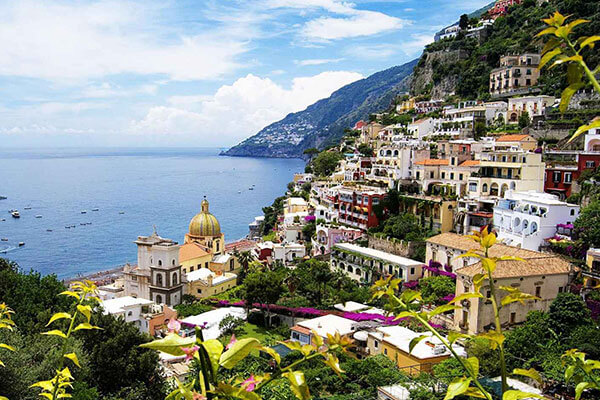
Transportation of Positano Salerno
Positano can be reached via the national road SS163 Amalfitana or the state road SP425.
The nearest airports are Naples Capodichino Airport and Salerno Pontecagnano Airport (QSR). A shuttle bus runs to destinations on the Amalfi Coast, such as Positano.
Ferries connect Positano with other cities such as Capri, Naples, Salerno, and Sorrento for transportation.
The Sita Bus connects Positano with Amalfi and Sorrento.
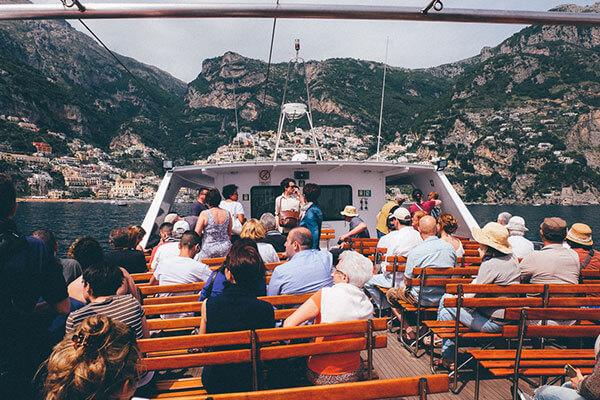
Best Things to Do in Positano
Walk the famous Positano streets
To learn more about Positano, one of the best activities to do in Positano is an afternoon stroll along its winding stone streets. It’s also a great way to explore this beautiful city. Go straight to Positano’s most famous attraction, the colorful Church of Santa Maria Assunta, which features a majolica-tiled dome.
It’s up to you after admiring the building’s impressive architecture. A small town, Positano. You’ll be able to return to the port area from wherever you are., and if you get lost somewhere, you never know what you’ll find. Spend time taking pictures of the colorful buildings and enjoying the stunning harbor views while sipping Italian coffee and wine.
Hidden treasures can be found on every corner and in the many boutiques, pottery, and gift shops. It’s also a perfect place to spend your time and some of your hard-earned money. Simply taking a stroll through this lovely seaside town will give you an idea of what to see in Positano.
Visit Mt Vesuvius and Pompeii
Among the best day trips from Positano, and conceivably the world’s most impressive archaeological site. Pompeii, which runs daily from Positano, is worth a visit. Buried in the ashes of the 79th-century eruption of Mount Vesuvius, the ruins offer an unparalleled glimpse into life in ancient Rome. Explore the ruins, visit the forums, baths, and out-of-town villas, and marvel at the everyday objects found during the excavations.
Mount Vesuvius, not far from Pompeii, is also a popular tourist attraction in Positano. Here you can drive up the slopes and hike to the crater. There are daily tours from Positano that combine these two attractions, usually with a good lunch.
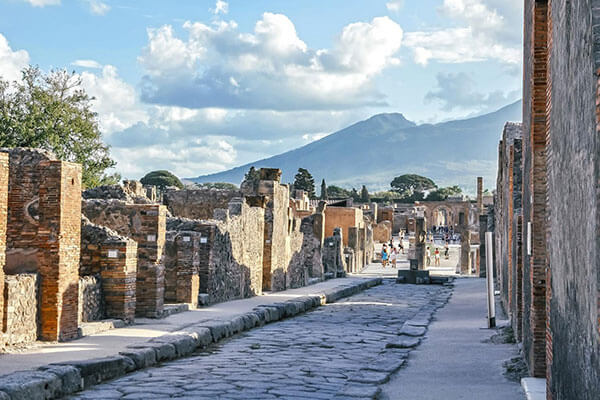
Go on a winery tour on the Amalfi Coast
The hills surrounding Positano are blessed with some of Italy’s finest vineyards, producing luscious red wines, crisp white grapes, and fragrant roses. A wine tour is a great way to taste the delicious local cuisine.
Discover the wonders of Capri
Capri is a legendary paradise island in the southern corner of the Gulf of Naples. Rich and famous people have long favored it, and for centuries its rugged beauty has captivated everyone from Roman emperors, to kings, and Hollywood superstars.
You can even join this list by taking a day trip to this charming resort and see for yourself why this tiny island has attracted so many over the centuries. Roman ruins, fine Italian cuisine, and designer boutiques line the streets, and much more. Sip wine in the picturesque Marina Piccola, or if you want to forget the glamorous atmosphere, explore the pristine countryside just outside the city. The strange cave known as Grotta Azzurra, which was found in the 19th century, is the island’s main tourist destination. It is worth a visit and, besides the blue pools, there are also ancient rock ruins and narrow caves.
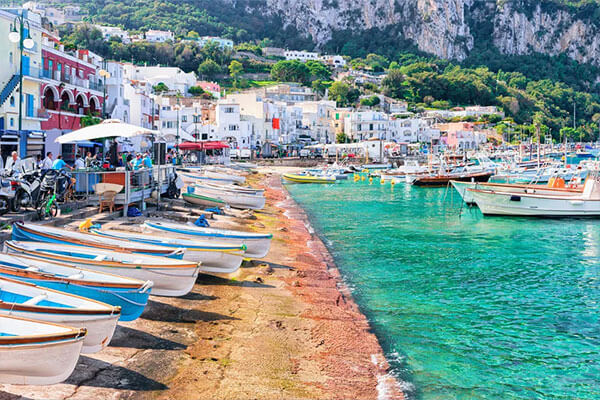
Visit a museum to learn about Positano’s past.
Learn about Positano’s ancient history by visiting the local Roman Archaeological Museum. The facility was recently inaugurated on the site of a former Roman villa under the chapel of the SS Church. Maria Assunta 7 in Piazza Flavio Gioia. Visitors can admire fragments of the original architecture and decorations, and learn more about Positano’s Roman history through multimedia exhibits that describe the ruins in more detail. The museum is open seasonally from 9 am to 8 pm.
11 April to 31 October until 30.30 pm and 1 November to 10 April from 10 am to 4 pm. Groups of up to 10 can also join a 30-minute guided tour. Only credit or debit cards are accepted for payment of the 15 euros per person entrance fee.



